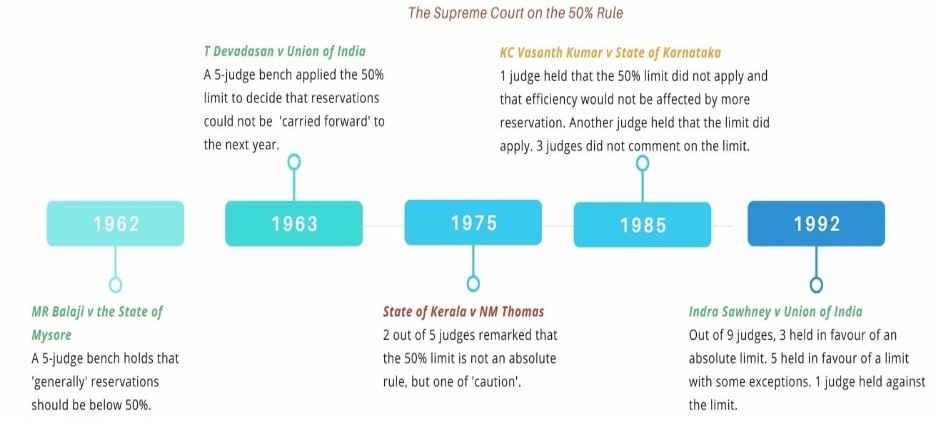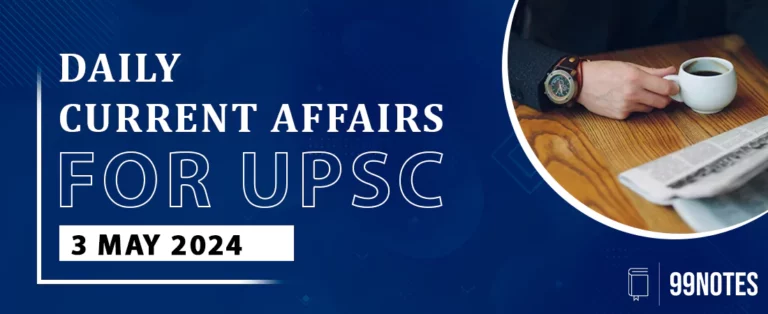22 June 2024 : Indian Express Editorial Analysis
1. In the name of merit
(Source: Indian Express; Section: The Editorial Page; Page: 10)
| Topic: GS2 – Polity – Judiciary
GS2 – Social Justice |
| Context: |
|
 Judicial Scrutiny of Reservation Policies:
Judicial Scrutiny of Reservation Policies:
- The judiciary in India has consistently applied the “strict scrutiny” doctrine to evaluate reservation policies.
- This approach has led to the nullification of reservation policies for communities such as Jats, Gujjars, Marathas, Patidars, and Muslims.
- The judiciary’s emphasis on “merit” and “efficiency in administration” has often overshadowed the principles of social justice intended by the Constitution.
The Patna High Court Judgment:
- A notable example is the 87-page judgment by Chief Justice K Vinod Chandran and Justice Harish Kumar of the Patna High Court, which struck down a 65 percent reservation policy in Bihar.
- This expansion was based on the Caste Survey of 2023, but the court’s decision aligns with the Supreme Court’s jurisprudence.
- This verdict is a setback for the Congress party, which has advocated for a Caste Survey in all states, removal of the 50 percent upper limit on reservations, and proportional representation for Other Backward Classes (OBCs).
Proportionate Representation vs. Adequate Representation:
- The High Court categorically rejected the concept of “proportionate representation” for Backward Classes, highlighting that this term is not found in Articles 15 and 16 of the Constitution.
- Instead, Article 16 uses “inadequacy of representation,” a concept that has been upheld by the Supreme Court in cases like Indra Sawhney (1992).
- However, the inadequacy of representation is related to the poor proportion of representation of backward classes, a nuance that the court acknowledged but did not fully address in terms of proportionality.
The 50 Percent Upper Ceiling:
- Another major reason for striking down the Bihar reservation amendment was the breach of the 50 percent upper ceiling for reservations.
- This judicial innovation was established in MR Balaji (1962) and has been consistently followed in subsequent judgments.
- While Indra Sawhney allowed some flexibility in far-flung or remote areas, the Patna High Court refused to consider Bihar as such an area, despite its low per capita income, high fertility rate, and other socio-economic challenges.
The EWS Reservation Controversy:
- The Supreme Court’s judgment in the EWS case (2023) applied the 50 percent upper ceiling only to SCs, STs, and OBCs, excluding the EWS category.
- This decision has been contentious, as no prior survey was conducted to examine the inadequacy of representation of the EWS category before extending reservations to them.
The Role of Expert Consultation:
- The High Court’s insistence on an “analysis” of the Caste Survey and consultation with experts poses additional constraints on the government’s affirmative action policies.
- While Indra Sawhney (1992) referred to expert consultation, the SC had approved Mandal’s 11 yardsticks of backwardness, deeming further expert input unnecessary.
Efficiency and Merit in Reservations
- The argument that reservations compromise efficiency and merit has been a recurring theme. However, no empirical evidence supports the claim that SC/ST/OBC employees perform less efficiently than general category employees.
- Justice Chinnappa Reddy in Vasanth Kumar (1985) criticized this notion, highlighting the elitist assumptions underlying it.
- Justice Chandrachud in B K Pavitra II (2019) called for redefining merit in terms of social good and inclusivity, aligning with the transformative vision of the Constitution.
Conclusion:
- The judiciary’s role in scrutinizing reservation policies underscores the tension between constitutional principles of social justice and judicial interpretations of merit and efficiency.
- The recent judgments highlight the challenges and complexities in implementing reservation policies that aim to balance these competing interests.
- As India continues to grapple with these issues, the need for a more inclusive and equitable approach to reservations remains paramount.
| Indra Sawhney & Others vs Union of India, 1992 |
|
· The Supreme Court while upholding the 27% quota for backward classes, struck down the government notification reserving 10% government jobs for economically backward classes among the higher castes. · SC in the same case also upheld the principle that the combined reservation beneficiaries should not exceed 50% of India’s population. · The concept of ‘creamy layer’ also gained currency through this judgment and provision that reservation for backward classes should be confined to initial appointments only and not extend to promotions. Fundamental Rights Article 14: Equality Before Law · It says that no person shall be denied treatment of equality before the law or the equal protection of the laws within the territory of India. · The right is extended to all persons whether citizens or foreigners, statutory corporations, companies, registered societies or any other type of legal person. Article 15: Prohibition of Discrimination · It provides that no citizen shall be discriminated on grounds only of religion, race, caste, sex or place of birth. Article 16: Equality of Opportunity in Public Employment · Article 16 of the Indian constitution provides for equality of opportunity for all citizens in matters of employment or appointment to any public office.
|
| Practice Question: Discuss the constitutional provisions and judicial interpretations related to reservation policies in India. How do these provisions balance social justice with the principles of merit and efficiency in administration? Illustrate your answer with recent judgments and their implications on governance and policy-making. (250 words/15 m) |
2. CLEAN AIR FOR THE YOUNG
(Source: Indian Express; Section: The Editorial Page; Page: 10)
| Topic: GS3 – Environment – Environment pollution and Degradation |
| Context: |
|
The Gravity of Air Pollution in India:
- India has grappled with severe air pollution for over two decades, particularly during the winter months when smog blankets vast regions.
- Despite significant concern and debate, responses have often been reactionary and short-term, such as spraying water to reduce dust and implementing vehicle restrictions like the odd-even scheme.
- These measures have failed to address the long-term public health implications of air pollution.
Vulnerability of Children:
- Children are particularly vulnerable to air pollution, inhaling more air per kilogram of body weight and absorbing more pollutants than adults.
- Their developing lungs, brains, and organs, coupled with weaker defense mechanisms, make them more susceptible to severe health conditions like asthma, upper respiratory tract infections, childhood leukemia, and high blood pressure.
- The high mortality rate among children due to air pollution highlights the urgent need for comprehensive strategies to protect this demographic.
Signs of Progress and Hope:
- Despite the grim statistics, there is hope. The SoGA report indicates that since 2000, the global death rate linked to air pollution among children under five has decreased by 53%.
- This improvement is attributed to increased access to clean cooking energy, better healthcare and nutrition, and heightened awareness of air pollution’s dangers.
- Implementing stricter air quality policies and promoting hybrid or electric vehicles have shown positive results in regions like Africa, Latin America, and Asia, offering valuable lessons for India.
The Way Forward for India:
- India faces a steep challenge in combating air pollution, particularly with 42 of the world’s 50 most polluted cities.
- A 2022 study highlighted a concerning lack of awareness about the links between air pollution, cancer, and heart disease among municipal employees, who should be leading the change.
- To effectively address this issue, India must prioritize the health of its citizens, especially children, in its policies and solutions.
- This requires a shift from short-term measures to comprehensive, long-term strategies that integrate public health considerations into air pollution control efforts.
Conclusion:
- The State of Global Air Report 2024 paints a stark picture of the impact of air pollution, particularly on young children. For India, the challenge is immense but not insurmountable.
- By learning from global examples and placing the health of its citizens at the core of its policies, India can make significant strides in reducing the deadly impact of air pollution and safeguarding the future of its youngest and most vulnerable population.
| Steps Taken by Government of India to combat Air Pollution |
|
National Clean Air Programme (NCAP): · Launched in 2019, NCAP is a comprehensive initiative with the goal of reducing air pollution in identified cities and regions across India. · The program focuses on improving air quality monitoring, implementing stricter emission standards, and promoting public awareness. Bharat Stage VI (BS-VI) Emission Standards: · The government implemented BS-VI emission standards for vehicles nationwide in 2020. · These standards aim to reduce vehicular emissions by mandating the use of cleaner fuel and more advanced emission control technologies. Pradhan Mantri Ujjwala Yojana (PMUY): · The PMUY scheme aims to provide clean cooking fuel to households by promoting the use of liquefied petroleum gas (LPG) as an alternative to traditional biomass-based cooking methods. FAME (Faster Adoption and Manufacturing of Hybrid and Electric Vehicles) Scheme: · The FAME scheme promotes the adoption of electric and hybrid vehicles to reduce air pollution caused by vehicular emissions. · Incentives are provided to both manufacturers and consumers to encourage the use of electric vehicles. Green Initiatives for Sustainable Habitat (GRIHA): · GRIHA is an initiative to promote sustainable and environmentally friendly practices in the construction and operation of buildings. · It encourages the use of energy-efficient technologies and materials to reduce pollution. Waste Management Programs: · Proper waste management is crucial to prevent the burning of waste, which contributes to air pollution. · Various waste management initiatives, including the Swachh Bharat Abhiyan, aim to address solid waste issues and promote cleaner disposal methods. Commission for Air Quality Management: · The Commission has been set up for Air Quality Management in the National Capital Region and Adjoining Areas for better coordination, research, identification, and resolution of problems surrounding the air quality index.
|
| Practice Question: Air pollution has become a critical public health issue in India, as highlighted by the State of Global Air (SoGA) Report 2024. Evaluate the effectiveness of current measures and policies in place to combat air pollution. Suggest comprehensive strategies that could be implemented to address this issue more effectively. (250 words/15 m) |




